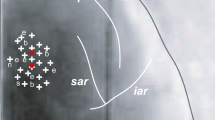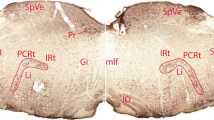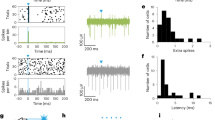Abstract
In a recent electrophysiological experiment, we showed the deep cerebellar nuclei to be a major source of excitatory input to the superior colliculus. Furthermore, target neurons in the colliculus were found, in every case, to receive convergent tonic inhibitory input from the substantia nigra pars reticulata. In the present study, we investigated these effects in the awake rat. We asked whether circling behaviour, induced by unilateral injection of a GABA antagonist into the lateral colliculus, could be suppressed by concurrent cerebellar inactivation. Rats were chronically implanted with bilateral guide cannulae located above the superior colliculus and deep cerebellar nuclei. Bicuculline methiodide (25 pmol) was microinjected unilaterally into intermediate layers of the colliculus at increasing depths until an optimal contralateral circling response was elicited. This behaviour was taken as the “baseline response” and was the first of three treatments. The second was an identical manipulation of the colliculus with a concurrent 200-nl microinjection of 1 M GABA into the contralateral deep cerebellar nuclei. The third was a repeat of BIC alone into the colliculus or, if rotation had been suppressed by more than 50% on test 2, the treatment was collicular BIC plus deep cerebellar saline. This latter treatment was used as a control for possible non-pharmacological injection effects. The effect of cerebellar GABA at 26 sites (17 within cerebellar nuclei and 9 outside) on BIC-induced rotation at 15 collicular sites was studied in ten animals. Only GABA injections at sites that fell within the cerebellar nuclei significantly reduced turning (P<0.0001). A full behavioural analysis showed that this was a specific suppression of turning, not the result of general motor impairment. These results provide clear behavioural evidence that opposing, convergent influences from the basal ganglia and cerebellum interact in the lateral superior colliculus to control head and body movements. They furthermore suggest that the tonic deep cerebellar excitation of the superior colliculus could be the driving force in the expression of rotation induced by manipulations of the basal ganglia.
Similar content being viewed by others
References
Bentivoglio M, Kuypers HGJM (1982) Divergent axon collateral from rat cerebellar nuclei to diencephalon, mesencephalon, medulla oblongata and cervical cord. A fluorescent double retrograde labelling study. Exp Brain Res 46:339–356
Bharos TB, Kuypers HGJM, Lemon RM, Muir RB (1981) Divergent collaterals from the deep cerebellar neurons to thalamus and tectum, and to medulla oblongata and spinal cord: retrograde fluorescent and electrophysiological studies. Exp Brain Res 42:399–410
Chalupa LM, Rhoades RW (1977) Responses of visual, somatosensory and auditory neurones in the golden hamster's superior colliculus. J Physiol (Lond) 270:595–626
Chevalier G, Deniau JM (1990) Disinhibition as a basic process in the expression of striatal functions. Trends Neurosci 13:277–281
Chevalier G, Deniau JM, Thierry AM, Féger J (1981) The nigrotectal pathway. An electrophysiological reinvestigation in the rat. Brain Res 213:253–263
Chevalier G, Vacher S, Deniau JM (1984) Inhibitory nigral influence on tectospinal neurons, a possible implication of basal ganglia in orienting behaviour. Exp Brain Res 53:320–326
Chevalier G, Vacher S, Deniau JM, Desban M (1985) Disinhibition as a basic process in the expression of striatal function. I. The striato-nigral influence on tecto-spinal/tecto-diencephalic neurons. Brain Res 334:215–226
Cicirata F (1989) Neocerebellar control of the motor activity: experimental analysis in the rat. Comparative aspects. Brain Res Rev 14:117–141
Cicirata F, Angaut P, Serapide MF, Panto MR, Nicotra G (1992) Multiple representation in the nucleus lateralis of the cerebellum — an electrophysiological study in the rat. Exp Brain Res 89:352–362
Dean P, Redgrave P, Sahibzada N, Tsuji K (1986) Head and body movements produced by electrical stimulation of superior colliculus in rats: effects of interruption of crossed tectoreticulospinal pathway. Neuroscience 19:367–380
Dean P, Mitchell IJ, Redgrave P (1988) Contralateral head movements produced by microinjection of glutamate into superior colliculus of rats: evidence for mediation by multiple output pathways. Neuroscience 24:491–500
Dean P, Redgrave P, Westby GWM (1989) Event or emergency? Two response systems in the mammalian superior colliculus. Trends Neurosci 12:137–147
Deniau JM, Chevalier G (1992) The lamellar organization of the rat substantia-nigra pars reticulata — distribution of projection neurons. Neuroscience 46:361–377
Di Chiara G, Porceddu ML, Imperato A, Morelli M (1981) Role of GABA neurons in the expression of striatal motor functions. In: Di Chiara G, Gessa GL (eds) GABA and the basal ganglia. Raven, New York, pp 129–163
Dunnett SB, Bjorklund A, Stenevi A, Iversen SD (1981) Grafts of embryonic substantia nigra re-innervating the ventrolateral striatum ameliorate sensorimotor impairment and akinesia in rats with 6-OHDA lesions of the nigrostrial pathway. Brain Res 229:209–217
Gerfen CR, Staines WA, Arbuthnott GW, Fibiger HC (1982) Crossed connections of the substantia nigra in the rat. J Comp Neurol 207:283–303
Glick SD, Jerussi TP, Fleisher LN (1976) Turning in circles: the neuropharmacology of rotation. Life Sci 18:889–896
Houk JC, Galiana HL, Guitton D (1992) Cooperative control of gaze by the superior colliculus, brainstem and cerebellum. In: Stelmach GE, Requin J (eds) Tutorials in motor behavior. Elsevier, Amsterdam, pp 443–474
Huston JP, Steiner H, Weiler H-T, Morgan S, Schwarting RKW (1990) The basal ganglia-orofacial system: studies on neuro-behavioural plasticity and sensory-motor tuning. Neurosci Biobehav Rev 14:433–446
Imperato A, Di Chiara G (1981) Behavioural effects of GABA-agOnists and antagonists infused in the mesencephalic reticular formation — deep layers of superior colliculus. Brain Res 224:185–194
Keay KA, Redgrave P, Dean P (1988) Cardiovascular and respiratory changes elicited by stimulation of rat superior colliculus. Brain Res Bull 20:13–26
Kilpatrick IC, Starr MS, James TA, MacLeod NK (1981) Evidence for the involvement of nigrothalamic GABA neurons in circling behaviour in the rat. In: Di Chiara G, Gessa GL (eds) GABA and the basal ganglia. Raven, New York, pp 205–224
Kilpatrick IC, Collingridge GL, Starr MS (1982) Evidence for the participation of nigrotectal gamma-aminobutyrate-containing neurones in striatal and nigral-derived circling in the rat. Neuroscience 7:207–222
King SM, Dean P, Redgrave P (1991) Bypassing the saccadic pulse generator: possible control of head movement trajectory by rat superior colliculus. Eur J Neurosci 3:790–801
Kirvel RD (1975) Sensorimotor responsiveness in rats with unilateral superior collicular and amygdaloid lesions. J Comp Physiol Psychol 89:882–891
Korneliussen HK (1968) On the morphology and subdivision of the cerebellar nuclei of the rat. J Hirnforsch 10:109–122
Kurimoto Y, Kawaguchi S, Murata M (1995) Cerebellotectal projection in the rat: anterograde and retrograde WGA-HRP study of individual cerebellar nuclei. Neurosci Res 22:57–71
Lee HS, Kosinski RJ, Mihailoff GA (1989) Collateral branches of cerebellopontine axons reach the thalamus, superior colliculus, or inferior olive: a double-fluorescence and combined fluorescencehorseradish peroxidase study in the rat. Neuroscience 28:725–734
Marshall JF (1979) Somatosensory inattention after dopamine depleting intracerebral 6-OHDA injections: spontaneous recovery and pharmacological control. Brain Res 177:311–324
Meredith MA, Stein BE (1986) Visual, auditory, and somatosensory convergence on cells in superior colliculus results in multisensory integration. J Neurophysiol 56:640
Meredith MA, Wallace MT, Stein BE (1992) Visual, auditory and somatosensory convergence in output neurons of the cat superior colliculus-multisensory properties of the tecto — reticulospinal projection. Exp Brain Res 88:181–186
Mulas A, Longoni R, Spina L, Del Fiacco M, Di Chiara G (1981) Ipsiversive turning behaviour after discrete unilateral lesions of the dorsal mesencephalic reticular formation by kainic acid. Brain Res 208:468–472
Nicholson C (1985) Diffusion from an injected volume of a substance in brain tissue with arbitrary fraction and tortuosity. Brain Res 333:325–329
Northmore DPM, Levine ES, Schneider GE (1988) Behaviour evoked by electrical stimulation of the hamster superior colliculus. Exp Brain Res 73:595–605
Paxinos G, Watson C (1986) The rat brain in stereotaxic coordinates. Academic, Sydney
Pycock CJ (1980) Turning behaviour in animals. Neuroscience 5:461–514
Redgrave P, Odekunle A, Dean P (1986) Tectal cells of origin of predorsal bundle in rat: location and segregation from ipsilateral descending pathway. Exp Brain Res 63:279–293
Redgrave P, Marrow L, Dean P (1992) Topographical organization of the nigrotectal projection in rat: evidence for segregated channels. Neuroscience 50:571–595
Sahibzada N, Dean P, Redgrave P (1986) Movements resembling orientation or avoidance elicited by electrical stimulation of the superior colliculus in rats. J Neurosci 6:723–733
Scheel-Krüger J (1986) Dopamine-GABA interactions: evidence that GABA transmits, modulates and mediates dopaminergic functions in the basal ganglia and the limbic system. Acta Neurol Scand 73:54–65
Scheel-Krüger J, Arnt J, Magelund G (1977) Behavioural stimulation induced by muscimol and other GABA agonists injected into the substantia nigra. Neurosci Lett 4:351–356
Sparks DL (1988) Neural cartography: sensory and motor maps in the superior colliculus. Brain Behav Evol 31:49
Speller JM, Westby GWM (1994) Bicuculline-induced circling from the superior colliculus is blocked by GABA microinjection into the deep cerebellar nuclei. Brain Res Assoc Abstr 11:51
Speller JM, Redgrave P, Westby GWM (1995) The cerebellotectal projection in the rat: anatomical evidence for topographical organisation. Brain Res Assoc Abstr 12:51
Sprague JM, Meikle TH (1965) The role of the superior colliculus in visually guided behaviour. Exp Neurol 11:115–146
Stein BE, Dixon JP (1979) Properties of superior colliculus neurons in the golden hamster. J Comp Neurol 183:269–284
Steiner H, Huston JP (1992) Control of turning behavior under apomorphine by sensory input from the face. Psychopharmacology 109:390–394
Tehovnik EJ (1989) Head and body movements evoked electrically from the caudal superior colliculus of rats: pulse frequency effects. Behav Brain Res 34:71–78
Tehovnik EJ, Yeomans JS (1986) Two converging brainstem pathways mediating circling behaviour. Brain Res 385:329–342
Teune TM, Vanderburg J, Ruigrok TJH, Voogd J (1995) Cerebellar modular organisation is maintained in nucleobulbar projections: an anatomical tracer study in the rat. Soc Neurosci Abstr 21:1191
Welzl H, Schwarting R, Kulajta J, Huston JP (1984) Perioral biting reflex and turning after intranigral injection of a GABA- or metenkephalin-agonist: role of the thalamus and superior colliculus. Exp Brain Res 55:438–444
Westby GWM, Keay KA, Redgrave P, Dean P, Bannister M (1990) Output pathways from the rat superior colliculus mediating approach and avoidance have different sensory properties. Exp Brain Res 81:626–638
Westby GWM, Collinson C, Dean P (1993) Excitatory drive from deep cerebellar neurons to the superior colliculus in the rat: an electrophysiological mapping study. Eur J Neurosci 5:1378–1388
Westby GWM, Collinson C, Redgrave P, Dean P (1994) Opposing excitatory and inhibitory influences from the cerebellum and basal ganglia converge on the superior colliculus: an electrophysiological investigation in the rat. Eur J Neurosci 6:1335–1342
Zetterstrom T, Herrera-Marschitz M, Ungerstedt U (1986) Simultaneous measurement of dopamine release and rotational behaviour in 6-hydroxydopamine dennervated rats using intracerebral dialysis. Brain Res 376:1–7
Author information
Authors and Affiliations
Rights and permissions
About this article
Cite this article
Speller, J.M., Westby, G.W.M. Bicuculline-induced circling from the rat superior colliculus is blocked by GABA microinjection into the deep cerebellar nuclei. Exp Brain Res 110, 425–434 (1996). https://doi.org/10.1007/BF00229142
Received:
Accepted:
Issue Date:
DOI: https://doi.org/10.1007/BF00229142




